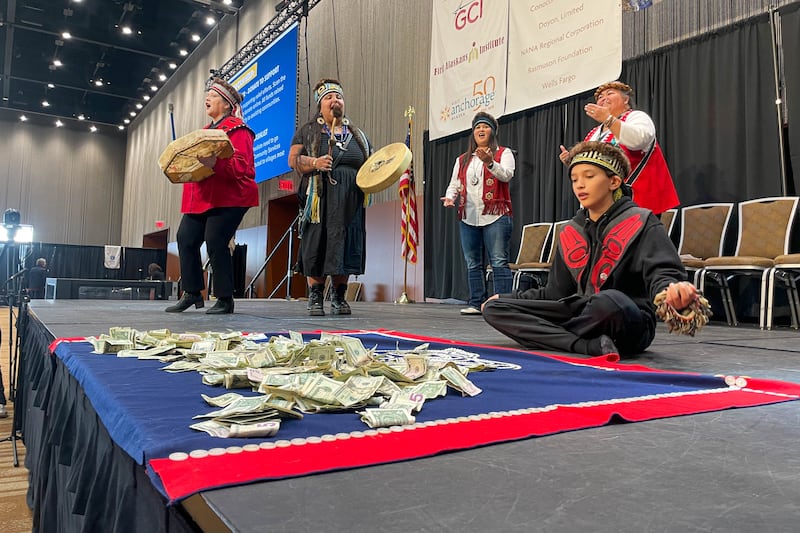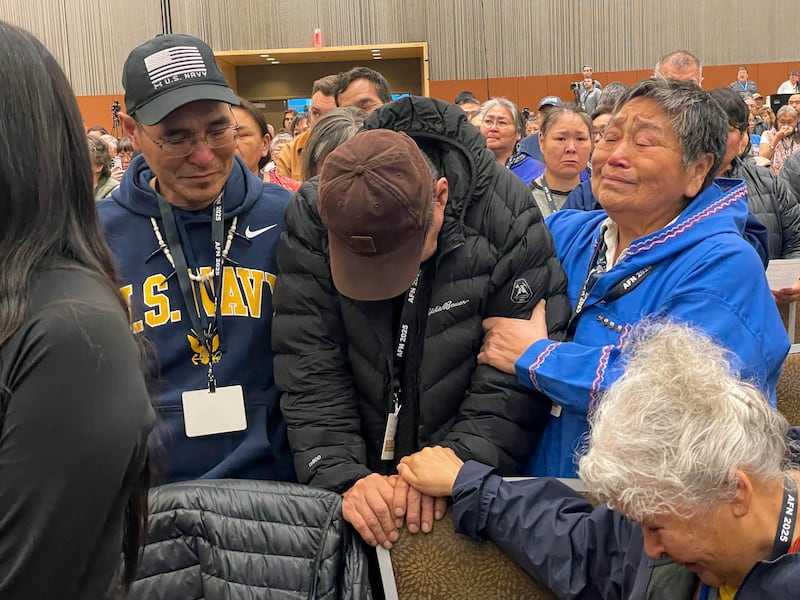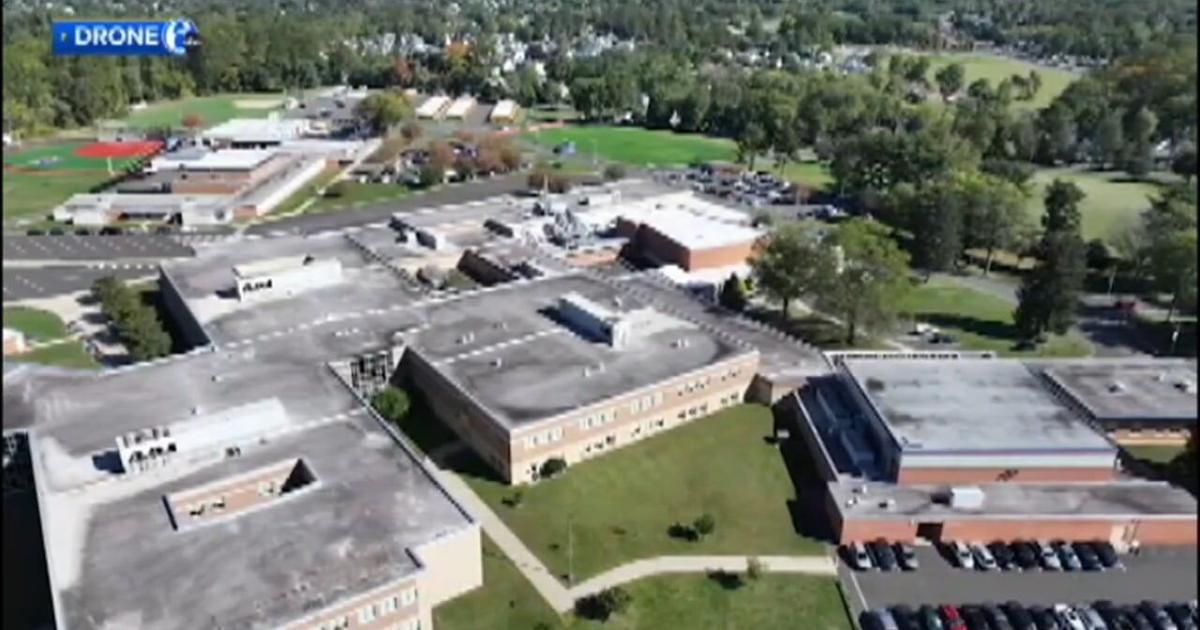State and local officials are preparing four shelters in Anchorage that could potentially accommodate more than 1,000 people displaced by unprecedented and catastrophic storms that have left whole Western Alaska communities largely uninhabitable.
As the municipality assists the state in its response, a total of 2,000 storm evacuees from Yukon-Kuskokwim Delta villages may ultimately be evacuated to Anchorage, Mayor Suzanne LaFrance said Thursday. The gap will likely be filled in by people staying with friends and family in the city or elsewhere, potentially in hotel rooms, officials said.
Roughly 260 people from the storm-damaged communities of Kipnuk and Kwigillingok arrived in Anchorage on a historic airlift from Bethel on Wednesday and are being housed in a mass shelter inside the Alaska Airlines Center at the University of Alaska Anchorage. They arrived with no more than a single bag, and some with just the clothing on their back.
Another 400 evacuees were expected to arrive Thursday, the city said.
A third wave of hundreds of additional evacuees could begin arriving Friday, according to the city.
To accommodate the displaced families, the city and its partners, including the American Red Cross, the state Office of Emergency Management and the Alaska National Guard, are opening three additional emergency shelters to house the expected evacuees.
The shelters will be located at the downtown Egan Center and the Fairview and Spenard recreation centers, in addition to the Alaska Airlines Center. Between the four, the city can temporarily house approximately 1,400 people, according to information from the municipality.
“We want to be a partner here and recognize the devastation and the loss that people have endured in Western Alaska,” LaFrance said. “I’m asking all of our residents here in Anchorage to greet folks who’ve been displaced with open arms.”
Emergency management authorities say people may be evacuated not only from the two hardest-hit communities, but also from the roughly 15 villages where homes were ripped from their foundations, crushed, moved miles by tides or contaminated with floodwaters. Some of the potential 2,000 evacuees thought to be coming to Anchorage may find places to stay with family members or be able to rent private homes independently.
[‘How we’re going to live’: Western Alaska residents airlifted to Anchorage face uncertainty]
It isn’t clear how long the immediate shelter needs will last: LaFrance said she expects that some of the evacuees will need to stay in Anchorage through the winter. The mayor said the municipality is working with the state and tribal leaders to find hotel rooms and other temporary housing options.
LaFrance said she recognizes housing in Anchorage is already limited, especially as homeless shelters prepare to increase capacity as winter nears.
“Clearly, the need is going up with this disaster in Western Alaska, and it’s unknown how many people right now will be able to go back to those communities, or when or how they will be rebuilt,” she said. “In the meantime, we are working very closely with partners and looking at ways that we can help to quickly scale up different kinds of housing.”
“We want to do everything that we can to ensure that folks have what they need to heal and to recover and to rebuild and to hopefully be able to reconnect with their communities,” LaFrance said.
On Friday, the Anchorage Assembly is holding an emergency meeting that will help the municipality continue to provide support to the state’s emergency response teams. Assembly members will consider temporarily expanding the definition of a civil emergency to include a state or federally declared disaster.
As the Anchorage code is currently written, civil emergencies usually apply to disasters that occur within the municipality. If the mayor is able to declare a civil emergency, it will help the city receive reimbursement for emergency-related expenses, said Emily Goodykoontz, a city spokesperson. It’s too early for cost estimates, Goodykoontz said.
‘A loss felt by all’
The storm and ongoing evacuations dominated discussions at the Alaska Federation of Natives’ 59th annual convention, which opened Thursday in Anchorage.
Speakers at the three-day event — one of the largest gatherings of Indigenous people in the world — shared messages of hope and resilience. They prayed for victims who lost property or loved ones.
“As we open this conference today, our hearts remain with the people impacted by the severe weather event,” said Ana Hoffman, co-chair of the Native federation and a resident of the hardest-hit region in Southwest Alaska.
“Our destruction is a loss felt by all,” she said.
The organization is hosting a donation drive to collect clothing, food, water, bedding and other items for victims on Friday and Saturday.
Overhead displays above the convention floor promoted online fundraisers, with QR codes directing donors to websites for an Alaska Community Foundation fund and an Amazon wishlist.
Early in the day, traditional dancers from Southeast Alaska performed a Haida blanket dance, raising more than $4,500 to help displaced families.
They beat skin drums and laid a traditional blanket onto the stage to collect cash. Dozens of convention-goers formed a long line to give money.
Mary Ayunerak of Alakanuk tossed in a $20 bill.
“I have to help,” she said.

During the convention’s opening invocation, Theresa John of Toksook Bay prayed in Yup’ik, the Alaska Native language for Southwest Alaska.
She talked about resilience and optimism, said Hoffman, a Yup’ik speaker.
“She talked about the rising of the water and that through the grace of the universe, the rate of survival was high,” Hoffman said in a break during the meeting, interpreting the Yup’ik prayer.
Convention delegates from Western Alaska sang a hymn, Nanraumali Atanerput in Yup’ik, or Praise Ye the Lord, with lyrics asking God to provide shelter.
Alan Peter, from the Western Alaska village of Nunam Iqua, lowered his head and sobbed during the song. Others moved close to comfort him.
Peter said Ella Mae Kashatok, Chester Kashatok and Vernon Pavil were his cousins. Ella Mae Kashatok was found dead in Kwigillingok in the aftermath of the storm, and the two others — also residents of Kwigillingok — remain missing.
“I was grieving for my family,” he said in an interview, adding that it was too difficult to say anything more.

‘We are in this together’
Hoffman said that the Yukon-Kuskokwim Health Corp., a large tribal health consortium in Southwest Alaska, approved a resolution calling on President Donald Trump to declare a national emergency, joining the Association of Village Council Presidents, another tribal entity from the region.
Bryan Fisher, director of emergency management for the state, said at the convention that the evacuation efforts are the most extensive in Alaska history. Some people whose houses were damaged many not be able to return home this year, he said.
[EPA defends canceling coastal erosion grant to hard-hit Kipnuk]
Fisher said Gov. Mike Dunleavy has talked with President Donald Trump about bringing in federal resources and agencies to help with the response.
He said a state program will provide cash assistance for repairs and rebuilding and to help displaced families find temporary housing either in their home communities or regions, or elsewhere.
“We are in this together and we will not leave your side for the entirety of this tragic event,” Fisher said, generating a standing ovation from the crowd.
Meanwhile, evacuees streamed into Anchorage and a new chapter of life.
On Thursday afternoon, Buggy Carl, a Kipnuk tribal administrator who has been posting frequent video updates throughout the storm and recovery, filed a dispatch from inside the military aircraft that took him and hundreds of others to Joint Base Elmendorf-Richardson in Anchorage.
He checked in again from the bus ride off base, and then once more from what he described as “the new community of Kipnuk and Kwigillingok” at the Egan Center in downtown Anchorage, pointing out family members in the background. The tears had continued for many of his fellow Kipnuk residents, he said.
“They’re coming through to the reality that most of the people’s houses are lost.”
First Appeared on
Source link












